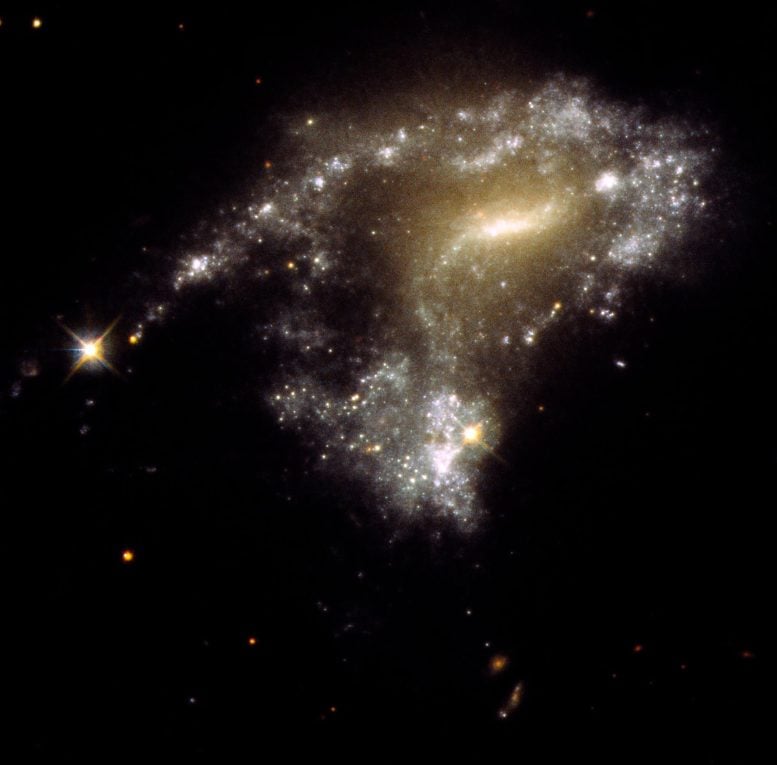NASA’s Hubble Space Telescope has observed 12 interacting galaxies, revealing long tidal tails rich in gas, dust, and stars, along which 425 clusters of newborn stars have been identified. These clusters, containing up to 1 million blue, newborn stars each, are a result of galaxy collisions that trigger star formation rather than destruction. Credit: NASA, ESA, STScI, Jayanne English (University of Manitoba)
Long Trail of Clumpy Stars Follows Galaxy Interactions
When galaxies go bump in the night, they cook up new generations of stars that might otherwise have never been born. These close encounters between galaxies cause a gravitational tug-of-war, and gas and dust are drawn out into large streamers. The Hubble Space Telescope’s vision is so sharp that it can see clusters of newborn stars strung along these tidal tails. They form when knots of gas gravitationally collapse to create about 1 million newborn stars per cluster. These “string of pearls” features are probably more common in the early universe when galaxies collided more frequently.

Galaxy AM 1054-325 has been distorted into an S-shape from a normal pancake-like spiral shape by the gravitational pull of a neighboring galaxy, seen in this Hubble Space Telescope image. A consequence of this is that newborn clusters of stars form along a stretched-out tidal tail for thousands of light-years, resembling a string of pearls. They form when knots of gas gravitationally collapse to create about 1 million newborn stars per cluster. Credit: NASA, ESA, STScI, Jayanne English (University of Manitoba)
Hubble Space Telescope Traces ‘String of Pearls’ Star Clusters in Galaxy Collisions
Contrary to what you might think, galaxy collisions do not destroy stars. In fact, the rough-and-tumble dynamics trigger new generations of stars, and presumably accompanying planets.
Now NASA’s Hubble Space Telescope has homed in on 12 interacting galaxies that have long, tadpole-like tidal tails of gas, dust, and a plethora of stars. Hubble’s exquisite sharpness and sensitivity to ultraviolet light have uncovered 425 clusters of newborn stars along these tails, looking like strings of holiday lights. Each cluster contains as many as 1 million blue, newborn stars.
Unveiling New Star Clusters
Clusters in tidal tails have been known about for decades. When galaxies interact, gravitational tidal forces pull out long streamers of gas and dust. Two popular examples are the Antennae and Mice galaxies with their long, narrow, finger-like projections.
A team of astronomers used a combination of new observations and archival data to get ages and masses of tidal tail star clusters. They found that these clusters are very young — only 10 million years old. And they seem to be forming at the same rate along tails stretching for thousands of light-years.
The Future of Tidal Tail Star Clusters
“It’s a surprise to see lots of the young objects in the tails. It tells us a lot about cluster formation efficiency,” said lead author Michael Rodruck of Randolph-Macon College in Ashland, Virginia. “With tidal tails, you will build up new generations of stars that otherwise might not have existed.”
The tails look like they are taking a galaxy’s spiral arm and stretching it out into space. The exterior part of the arm gets pulled like taffy from the gravitational tug-of-war between a pair of interacting galaxies.
Before the mergers, the galaxies were rich in dusty clouds of molecular hydrogen that simply may have remained inert. But the clouds got jostled and bumped into each other during the encounters. This compressed the hydrogen to the point where it precipitated a firestorm of star birth.
The fate of these strung-out star clusters is uncertain. They may stay gravitationally intact and evolve into globular star clusters — like those that orbit outside the plane of our Milky Way galaxy. Or they may disperse to form a halo of stars around their host galaxy, or get cast off to become wandering intergalactic stars.
This string-of-pearls star formation may have been more common in the early universe when galaxies collided with each other more frequently. These nearby galaxies observed by Hubble are a proxy for what happened long ago, and therefore are laboratories for looking into the distant past.
Reference: “Star clusters in tidal debris” by Michael Rodruck, Jane Charlton, Sanchayeeta Borthakur, Aparna Chitre, Patrick R Durrell, Debra Elmegreen, Jayanne English, Sarah C Gallagher, Caryl Gronwall, Karen Knierman, Iraklis Konstantopoulos, Yuexing Li, Moupiya Maji, Brendan Mullan, Gelys Trancho and William Vacca, 29 September 2023, Monthly Notices of the Royal Astronomical Society.
DOI: 10.1093/mnras/stad2886
The Hubble Space Telescope is a project of international cooperation between NASA and ESA. NASA’s Goddard Space Flight Center in Greenbelt, Maryland, manages the telescope. The Space Telescope Science Institute (STScI) in Baltimore, Maryland, conducts Hubble and Webb science operations. STScI is operated for NASA by the Association of Universities for Research in Astronomy, in Washington, D.C.





